On command, Marie Komara jolts into a race against time.
In no more than a minute, she dons full turnout gear—pants, coat, gloves and a helmet built to brave heat and harm. The next minute, a breathing mask and air tank.
So far, so quick. But still, not a second to waste.
Engulfed by dozens of pounds of equipment, she performs a grueling series of drills: dragging a hose, swinging an ax, climbing the equivalent of six stories on a stairmill.
Then, the real test.
Komara marshals her 5-foot-2 frame to hoist a 72.6-pound aluminum ladder onto her right shoulder and advances toward the front of the house. She pivots the base to the ground. Using her right heel as a stabilizer beneath the lowest rung, she pulls a halyard to extend the ladder to its full 24-foot length.
With the ladder in place, she drapes a hose line over her shoulder and climbs to the roof. Going through those motions in reverse, she retracts the ladder, swings it back over her shoulder and hauls it away to set it down.
The steady pace belies her exertion, which becomes apparent when she peels away her fogged-up face mask and unclasps her helmet and headgear. Cheeks flushed, blonde hair matted with sweat, she smiles while catching her breath outside her coach’s South San Jose home. The curved driveway has become a proving ground for women trying to beat the odds in one of the nation’s final frontiers for gender parity.
“She’s come a long way,” Shay Mountford, 51, says of her mentee.
Of all hurdles to becoming a firefighter, the toughest for women may well be the ladder throw, Mountford explains. That Komara pulls it off makes her a statistical anomaly in a field where 70 percent of aspiring firefighters—male and female—quit before passing the required tests. All the more impressive: that she pulls it off after an injury at the 2007 Olympic weightlifting trials left her once facing the prospect of never walking again.
“What she’s done after what she’s been through is amazing,” Mountford says.
A Silicon Valley firefighter for more than two decades, Mountford and her wife, life coach Kristi Mountford, founded Blaze of Glory Fitness five years ago to address an intractable shortage of women in the field.
“I assist in fire academies,” Mountford says, “and I just noticed the general consensus with departments throughout the Bay Area, throughout the country, that women specifically have a tough time getting through the physical tests. Even if they did, I noticed that a lot of good people were getting hired and then getting let go.”
Through Blaze of Glory, she figured she could train women—and some men—to develop the upper-body strength, grip and work-smart-not-hard skills to break those barriers.
“If I could take care of those issues right out the gate, I knew I could get more women set up for success,” she says. “They get a job out of it, but this also benefits the fire agency, which loses a minimum of $10,000 per recruit if they fail the academy.”
“It’s a win-win.”
To date, Mountford says 95 percent of her athletes have cleared academy and probation at a host of Bay Area fire agencies, giving one in 2018 its first female Asian-American hire. It’s a track record that undermines a persistent narrative in the field about women, or diminutive candidates, only qualifying under lower standards.
“Women who learn techniques that work for their body type and get some help preparing ahead of time can absolutely have what it takes,” says Amy Hanifan, operations chief for McMinnville Fire Department in Oregon and president of national nonprofit Women in Fire. “Some departments offer materials or resources for that.”
But many still don’t. And it shows.
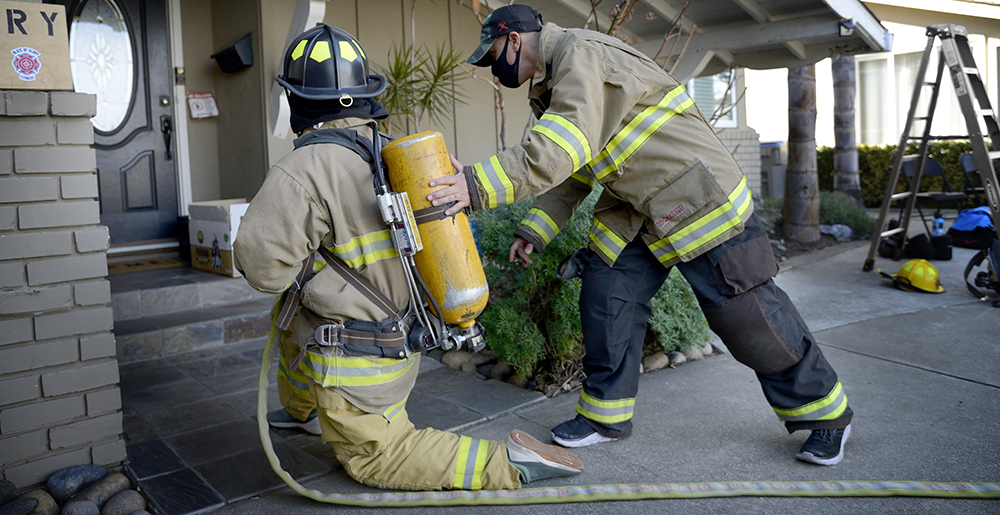
TRIAL BY FIRE: Marie Komara (left) takes a knee while Shay Mountford (right) offers encouragement after a workout. (Photo by Greg Ramar)
Call and Response
Even as female representation has risen to about 14 percent in traditionally male-dominated police and military work, according to the U.S. Department of Labor, women comprise just 4 percent of career firefighters.
Nearly 50 years after the first American woman began collecting a paycheck for firefighting, the job remains one of the few where a virtual male monopoly persists. It’s still possible in 2021 for cities to hire their first female firefighters.
While a number of big-city departments—most notably San Francisco’s—have improved female representation by investing in targeted recruitment and training, some of Silicon Valley’s biggest fire agencies have trended in the opposite direction.
Since 2009, the number of women firefighters at the Santa Clara County Fire Protection District fell from 22 to 16—or 7 percent—of 235 first responders. During the same timeframe, Palo Alto’s 95-person fire force went from employing 10 women to five.
The Bay Area’s most populous and nation’s 10th largest city fared even worse. San Jose went from employing 35 female firefighters in 2009 to just 16 a decade later—a three-point drop to an infinitesimal 2 percent of the city’s 665 firefighters.
Last year’s Santa Clara County Civil Grand Jury made the waning diversity of South Bay’s largest fire agencies the subject of an alarming report, which questioned why a region with a reputation for progressive practice and policy would fail so miserably when it comes to female representation.
“Firefighting has been characterized as a calling as much as a career choice,” the 33-page document states. “It is demanding both physically and mentally. It requires knowledge of the latest firefighting techniques, lifesaving procedures, rigorous attention to physical fitness and the demands of living away from family for days at a time. The profession should never favor one gender over another in qualifying for employment, but simply progress candidates who pass written and physical tests and the interview process.”
The civilian watchdog group focused its review on the Palo Alto, San Jose, Mountain View and county fire departments, which in the decade since 2009 saw, at most, a combined average of 5.2 percent female representation. At the end of the decade, that figure collectively fell below the national average to 4.1 percent.
In the decade scrutinized by the grand jury, 2016 saw the largest number of firefighter applicants among the four agencies, which collectively fielded 2,000 candidates—68 of whom identified as female and six who didn’t specify a gender. Of that applicant pool, the agencies made conditional employment offers to 40 men and one woman. After the final oral interview, 31 men and no women got the job.
Of the four departments examined by the oversight body, only Mountain View’s boosted the number of women on the force, the report noted. And it managed to do so by taking a cue from San Francisco, funding female-centered recruitment five years ago, bringing the proportion of women on the force to 10 percent—just about double the national average.
Even so, Mountain View and San Francisco both were well below the 17 percent female representation recommended by Women in Fire, among other advocacy groups.
Grand jurors chalked up the problem to a lack of institutional investment in gender-specific hiring. Based on gains in Mountain View and San Francisco, they concluded: “efforts to recruit women in both departments resulted in more women being hired.”
That should be an obvious point. But in San Jose, to name an example among many, female recruitment is relegated to private coaching or volunteers. Though San Jose’s fire department provides facilities and equipment to its nascent Women’s Boot Camp, the trainers lend their expertise on their own time.
Karen Allyn, who made history as SJFD’s first female firefighter 40 years ago, says she felt honored to volunteer her time at last year’s bootcamp. But she wonders if SJFD relying on unpaid coaches to tackle gender disparity might explain why the number of women at the department declined so dramatically since she retired in 2009.
“It’s sad,” she says. “It’s discouraging to hear how things have regressed. There were a lot of us women, and some of the men, who had some hard-fought experiences to make things better, and to see that diminished is unfortunate.”
In SJFD Chief Robert Sapien’s response to the civil grand jury report, he acknowledges “not meeting the mark” and touts the volunteer-run bootcamp launched in 2019 as the department’s primary means of improving gender diversity. Whether he’ll push to formalize the training with a budget allocation remains to be seen.
Retention, meanwhile, is a battle unto itself.
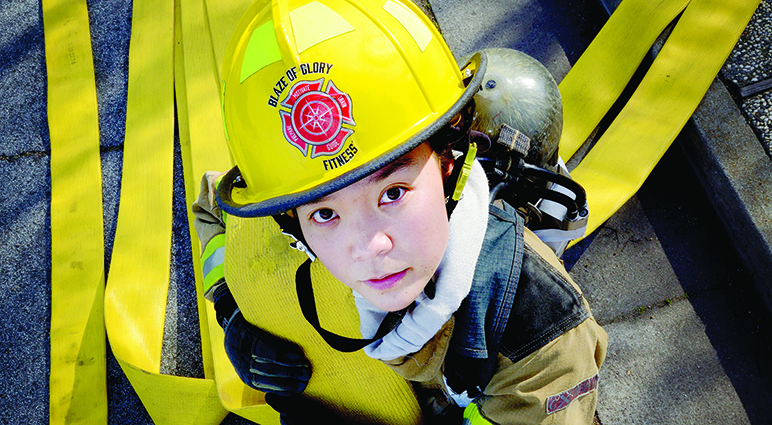
SIREN SONG: Ruri Kobayakawa, 26, found her way to firefighting through her work as an EMT. (Photo by Greg Ramar)
Locks and Lawsuits
A radio ad piqued Karen Allyn’s interest in firefighting. She was in her early 20s when she heard the San Jose Fire Department put out a call over the airwaves for women and people of color to apply, so she jumped at the chance.
“When I was hired, it was a really good-paying job for women,” she recalls. “At least for me it was. Plus, it seemed exciting and I wanted to do something out of the ordinary.”
She was 22 at the time, athletic and able. Thanks to a firefighter who introduced her to the equipment and told her and other prospective candidates about the physical demands of the job, she passed the rigorous fitness requirements and in 1981 became the first female firefighter since SJFD’s founding in 1854.
Despite initial resistance, hazing and scorn from some veteran firefighters, Allyn eventually earned their respect by excelling on the job. Another five years would pass before San Jose hired its second female firefighter, Patricia Tapia, in 1986.
As Allyn notched more years under her belt, she began advocating for more inclusive work conditions. Like most fire agencies in the U.S., San Jose’s stations were built with group showers, no doors on the bathroom stalls and next to nothing in the way of privacy. In the late 1980s, along with SJFD colleague John McMillan, she pushed the city for basic improvements, including door locks, separate showers and changing rooms.
SJFD’s modernized facilities put its few female firefighters more at ease. But Allyn faced more challenges, even as she rose through the ranks and racked up experience. Each time she gave birth, the department had her redo the same physical test she took upon her initial hire—an exclusively female requirement.
“I had two kids, so I took it both times eight weeks after giving birth,” Allyn says. “For me, it was a good measure of my physical ability. But it wasn’t fair.”
Women already struggled with ill-fitting gear, she says, and pregnant women even more so. When she and another pregnant firefighter were testing to become engineers, she says the department forbade them from donning maternity wear.
“Policies like that, over time, end up deterring women from advancing,” Allyn says.
At times it took litigation to level the playing field.
In 2017, a jury awarded $800,000 to SJFD Battalion Chief Patricia Tapia while ruling in favor of a retaliation claim she filed jointly with Capt. Debra Ward. The pair claimed the department retaliated against them for winning a legal settlement in a 2012 lawsuit accusing SJFD of repeatedly passing them over for promotions.
Tapia ultimately landed the promotion she wanted, but there was no ceremony. In her 2012 complaint, she wondered, “Why do women have to continue to do more than men? Why do I have to jump through more hoops than the less-qualified males?”
While conditions and attitudes have improved for women in the fire service, some of the same challenges Allyn faced as a pioneers in the field persist to this day.
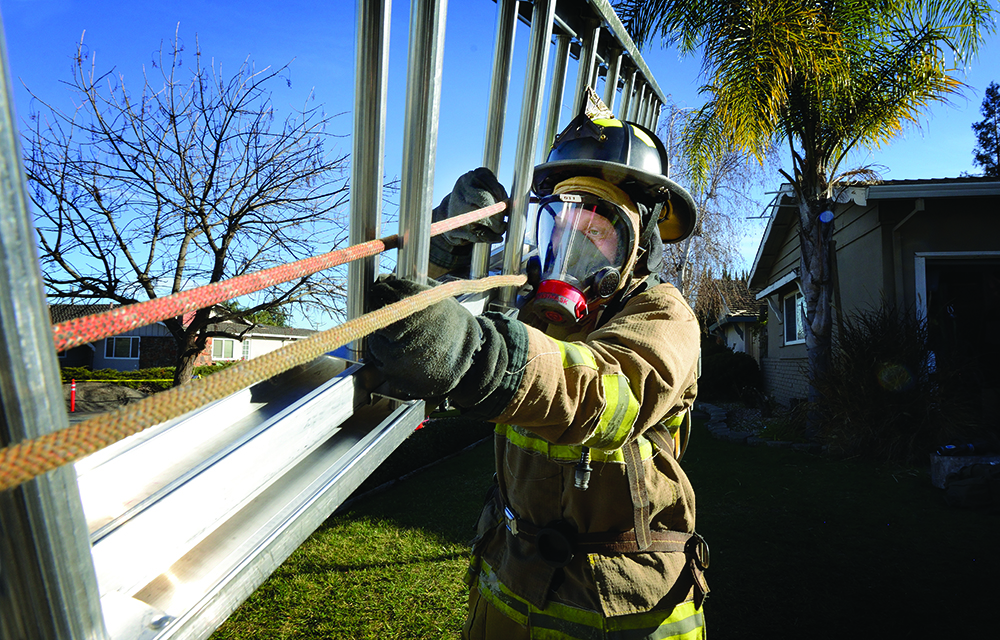
STEP BY STEP: Lifting and extending ladders, as demonstrated by 32-year-old Marie Komara (pictured), are one of the biggest obstacles to women and smaller-statured people trying to break into firefighting. (Photo by Greg Ramar)
Double Standards
Once hired, women are still more likely than their male peers to deal with hostile work environments, sexual harassment and discrimination. A lack of privacy at shared facilities, limited accommodations for pregnancy and family leave and few mentorship opportunities make it all the more daunting for women to stick with the profession.
The National Report Card on Women in Firefighting, which publishes an annual survey of women and men in the fire service, found that 85 percent of women surveyed in 2020 claimed different treatment based on gender compared to 12 percent of men.
Most female respondents say they encountered problems with ill-fitting equipment, witnessed authority of women in supervisory positions challenged or experienced isolation and shunning because of gender.
While 7 percent of men surveyed saw gender as a barrier to career advancement, more than a third of women felt the same. Just 5 percent of men and up to 40 percent of women reported enduring verbal harassment, exposure to pornography on the job, sexual advances, hazing and hostile notes.
A 2018 study by Drexel University on the experiences of 30 women firefighters echoed similar findings. Most of the women interviewed for the study said they faced doubled standards. “We’re assumed incompetent, basically, inferior and incompetent,” a 25-year fire service veteran told researchers.
Reality belies such assumptions.
The national report card on women in firefighting found that female applicants tend to have greater physical and academic qualifications.
Last year’s survey reported that 35 percent of women applying for firefighting jobs were former athletes compared to 15 percent of men. Because women generally decide to become firefighters later in life, more of them have college degrees when they apply: 65 percent compared to 47 percent of men.
Those figures track with what Mountford sees in her trainees.
Ashley Monzon, Di-an Duong and Ruri Kobayakawa are all athletic twenty-somethings who found their way by word of mouth to Blaze of Glory after college and at least a few years in a related field. As women and Asian-Americans, they say it took them years into adulthood before they entertained the possibility of a fire career because they never saw themselves represented in the profession.
“By the time I decided this is what I want to do for a living, I’d gained all this other valuable experience,” Duong, 28, says. “It laid the foundation.”
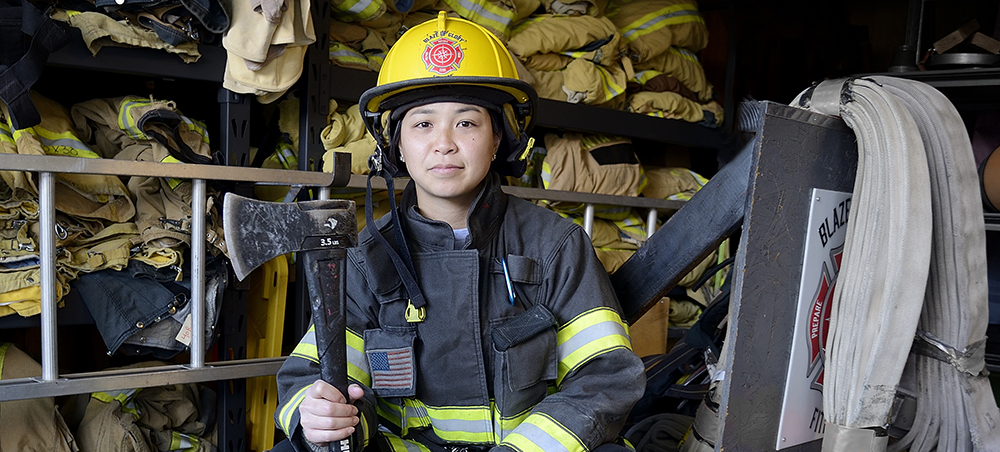
BLAZING A TRAIL: Di-an Duong is one of the women looking to put an end to gender inequity in firefighting. (Photo by Greg Ramar)
Better Techniques
Growing up in a Vietnamese household, Duong says the family imparted expectations that she become a doctor or lawyer.
“Those were the only career choices I ever thought of,” she says.
Of those options, she says the medical field seemed most appealing. Her mother’s ultimately fatal seven-year battle with cancer brought the family in regular contact with first-responders, nurses and doctors, Duong recalls. She says that gave her an appreciation for life-saving frontline work.
In college, she took up rugby and a part-time fitness training job while studying to be a chiropractor. But her heart wasn’t entirely in it, she says. Sensing the uncertainty, her family told her to consider applying for a branch of the military.
One uncle half-jokingly suggested firefighting.
“He was simultaneously encouraging and doubtful,” Duong says. “But the idea stuck.”
Having dedicated a few years to powerlifting and bodybuilding, she felt cut out for the job, despite her 5-foot-2 stature. In 2017, she began training with Blaze of Glory. The next year, she landed a firefighting position at a prominent South Bay fire agency and continued working with Mountford as a coach.
A few years into the job, Duong says she’s increasingly realized that women bring unique contributions to the field. Sexual assault survivors, for example, might be more comfortable with a female firefighter-paramedic.
Female physiology also tends to require creative techniques that Duong and Mountford believe can improve safety for everyone. Researchers affirmed as much in a study published four years ago in the Journal of Workplace Behavioral Health, which determined that firefighters “deviating from the modernist American hyper-masculine norm may have a positive impact on their work practices and injury outcomes.”
“We use better technique and a lot of guys get hurt because they just try to muscle it, or god forbid that they ask somebody for help and god forbid they ask a woman to help with a ladder,” a 15-year female firefighter told the team of federally funded researchers. “So a lot of guys will just muscle things that really would be more efficient as a two-person job. And women I think are smart enough, especially once you get on [the job] long enough, maybe not when I was younger, but when you’ve been on long enough to say you know what, I need help and I’m just gonna ask for help.”
Women in the study talked about taking it upon themselves to reach out to female probationary firefighters—called “probies”—to share biomechanical tricks to avoid tiring themselves out as much as they would by “muscling through” certain tasks.
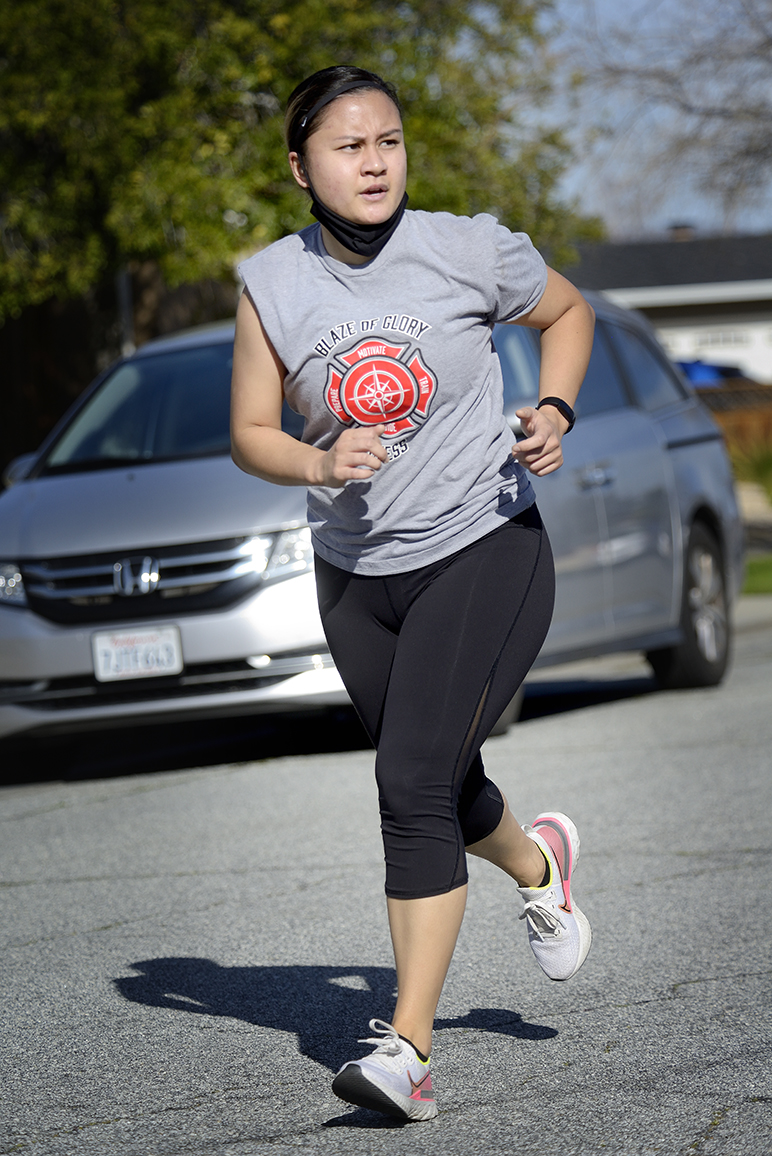
TRAINING DAY: Aspiring firefighter Ashley Monzon, 28, says she always looked up to first responders for running toward the danger and was drawn to the profession out of a desire to help. (Photo by Greg Ramar)
“Everything is technique, because what works for someone who’s taller, like going back to the ladder, the taller you are on the ladder carries, the easier it is. It isn’t even strength on the ladder,” a 20-year female firefighter said in the study. “The shorter you are, it’s a different fulcrum. So I have to use a different technique from someone who’s 6 foot. And you just have to find out what works well for you, and that’s men or women. There are guys that aren’t that tall. So you just have to find the technique for you.”
A 2014 report by Women in Fire noted that physical abilities metrics only became the norm after it became illegal for fire departments to reject applications from women outright.
“It may or may not be coincidental that this was the same time period when women first showed a serious interest nationally in entering the career fire service,” the study’s author, Linda Willing, wrote.
“Entry-level tests have become part of the folklore of some fire departments, usually because their test is so difficult that few candidates can pass it,” she continued. “Those who do pass then adopt a ‘best of the best’ attitude, and take great pride in their achievement. Unfortunately, because these tests can be so revered in departmental tradition, it can be very difficult to analyze or change them for any reason.”
The fact is, she says, they can and should evolve.
From the early ’80s to late ’90s, many departments imposed tests for speed and strength—like hauling a 120-pound dummy over one’s shoulder—that put women at a disadvantage and didn’t reflect the stamina, problem-solving and teamwork required for the job. The CPAT, which stands for Candidate Physical Ability Test, became standardized in the early aughts to prevent agencies from adding drills with little bearing on what firefighters do in the field.
CPAT, a 10-minute-20-second tryout, is the point of entry.
The real learning comes after clearing that baseline and making into the fire academy, some of which allow techniques more suitable for women and smaller-statured people—like holding a ladder by the rungs instead of the frame for extension drills.
Blaze of Glory works with trainees far beyond those rites of passage, providing ongoing mentorship and inviting former pupils back as coaches.
As Mountford sees it, women—physiological differences notwithstanding—are more than capable of meeting even the toughest academy requirements, given the right training, camaraderie and confidence.
She would know.
During her initial foray into the fire service, she says she weighed “no more than 115 pounds soaking wet.” It took her six years of testing and strength-building before she graduated at the top of her academy and was hired at the age of 32, in 2002.
Though she’s been lucky enough to work at a department where she didn’t face the kind of discrimination described by so many women, she says she understands full well the physical obstacles and how to surmount them. “If women are taught proper technique and build strength on top of that,” she says, “they excel.”

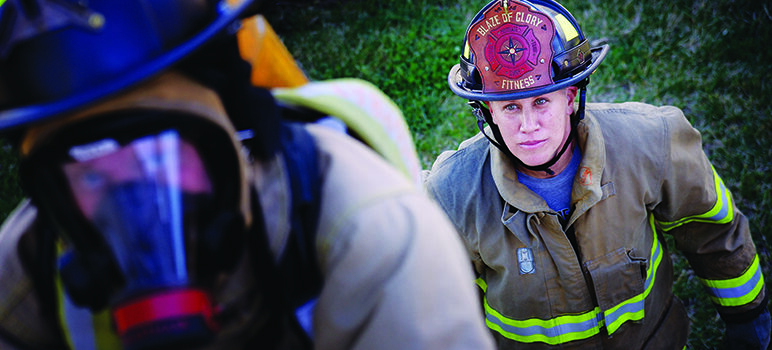
“If I could take care of those issues right out the gate, I knew I could get more women set up for success,”
finally some truth
tough love and honesty up front is infinitely better than cruelty of kindness
take out the qualifier “women” and replace with anyone trying something
being nice, showing empathy does nothing, disabusing people of self destructive or counterproductive habits RIGHT OFF THE BAT can change lives
Knock yourselves out gals. Get these gender inequities taken care of. But don’t just focus on the high paying early retirement big pension careers. People might get the idea that you’re only in it for the money and the hero worship or just to prove some point.
Let’s see the same enthusiasm for closing the gender gap in garbage collection, in roofing, in ditch digging etc. It’d do wonders for your credibility.
As a former Firefighter I can say without a doubt there are many truths in this article, however, it is also flawed with opinion and not facts. This career, and that is what it is, is not a job but a 20+ year commitment. Anyone, male or female needs to understand this before moving forward. The Fire Service is not a place where social engineering is to be tested or experiments to be conducted. It is a Meritocracy and so I take exception to the comment questioning (as if it is a bad thing) “The Best of the Best” attitude. We want the best of the best (Male or Female) not just anyone. The study that cited the number of women firefighter candidates that were college athletes as compared men applicants is silly at best because it makes the claim or the jump, that, and I quote, (women) “have greater physical and academic qualifications….. that 35 percent of women applying for firefighting jobs were former (college) athletes compared to 15 percent of men” This is an Apples to Oranges comparison. The academic quality of Female Applicants is with out a doubt superior! Many of my fellow Women Firefighters had College Degrees as compared to my Male counterparts. But to think or compare a Male High School Varsity Athlete to a Women’s college Athlete is silly. Example: At the California High School State Track Meet The Male 100 meter dash winner wins the Olympic Women’s Gold Medal by almost half a second which in track is nearly 25 feet!!!!!! In fact the High School 10th place finisher beats the Women’s Olympic winner by a nose! Now I doubt that many of the Males that competed at the California State meet, especially the guy that finished 10th is getting a Track Scholarship! In fact I would say that none of the Final times listed for that state meet are getting any kind of College offers…..their times are to slow as compared to the top times nationally and scholarships available (12.6 per Male Track Team if it is fully funded and spread among all the other events) for track!!!! The key, and it was well stated in the article, is Technique!!!!! It prevents injury, it saves time, it a sign of a well trained Firefighter. The physical Standard is just a “Baseline” and must be maintained for an entire career, and so, if a firefighter has difficulty with making the baseline standard they will have issues down the road and this applies to both Male and Females. The real questions, is the standard being used realistic of the expected work to be done? This is the great debate. But like any Team we have those that are better at some aspects of the job and others that are better in other areas of the job, but together we can get the job done!!!!
On point and well written. As someone who has lived through the experience of being a female firefighter this rings very true. There is change, albeit slow. There are leaders within the Fire Service that support and respect women. If you want to see a great model of how women should be treated within the Fire Service, equally, in a safe environment – head down to Cal Fire in Morgan Hill. Nothing but respect for their professionalism. And that’s coming from a female that’s seen it at its worst.
This is a topical issue now because the topic of gender equality is still heard everywhere. Although everyone should already understand that we are equal in our rights and responsibilities. I still read short lines on my page about gender equality in education and the gender wage gap. This is relevant and should be clear to everyone, otherwise, why do we constantly talk about it and emphasize it.